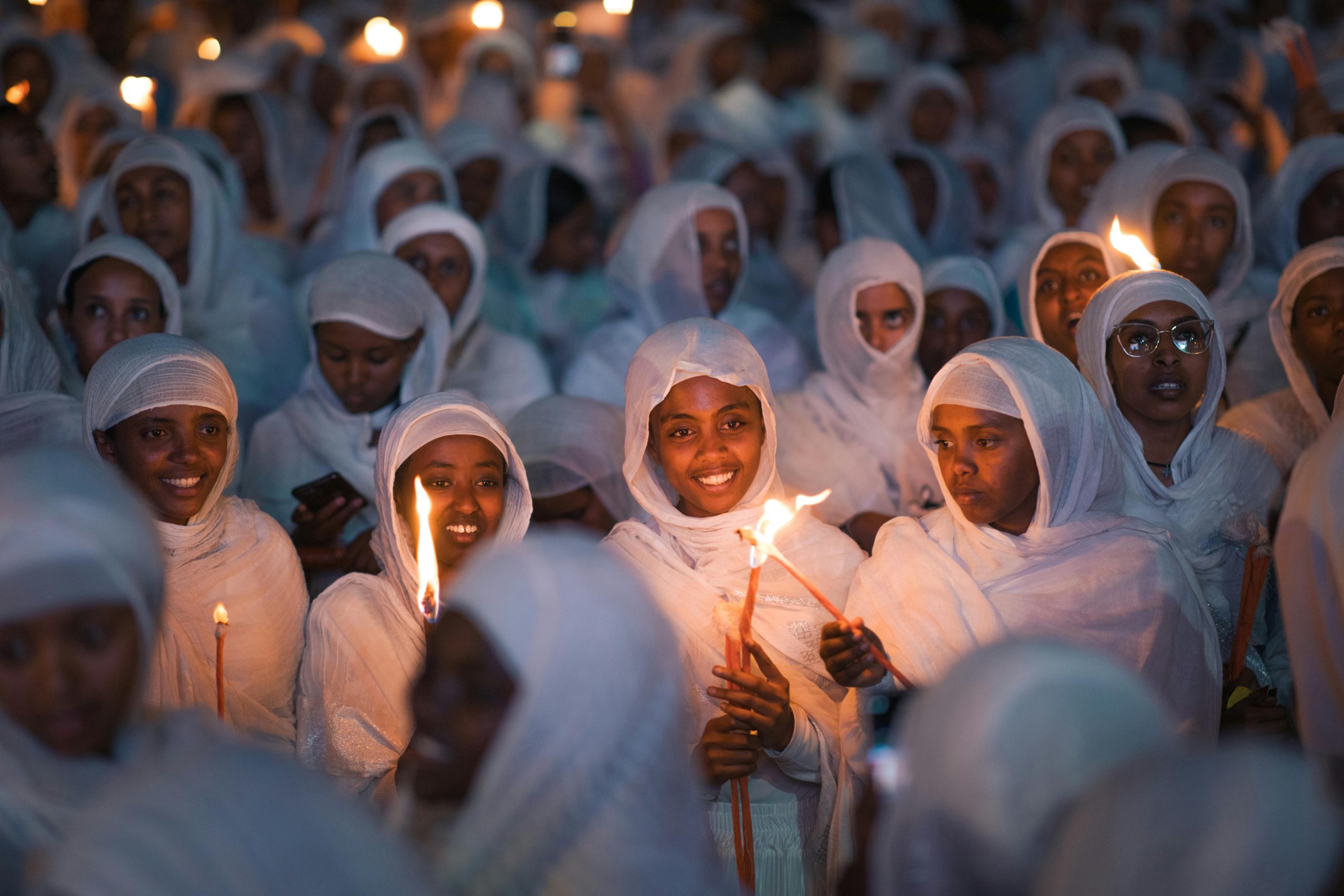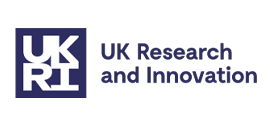
Source: Gift Habeshaw
In this blog, Revd Dr Calum Samuelson explores the ancient spiritual formation practices of the Ethiopian and Eritrean Orthodox Täwaḥǝdo Churches (EEOTC), particularly through the lens of the Books of the Monks (BoM)—a vast, mystical, and underexplored collection of monastic texts central to the tradition’s theology and practice. Revd Samuelson’s research focuses on how theōsis is subtly but pervasively embedded in the BoM. He argues that while these texts are often seen as relevant only to monastics, they carry rich insights that are highly relevant for the broader Christian community today.
For the last five years, I have studied various aspects of spiritual formation in the Täwaḥǝdo Christian tradition of the Ethiopian and Eritrean Orthodox Churches (EEOTC). My PhD research focused on the ways that theōsis (or ‘deification’) is expressed in a vital set of texts called the Books of the Monks (መጻሕፍተ መነኰሳት; henceforth ‘BoM’). These texts are widely known in the EEOTC but seldom studied in depth except by monastics—for whom they constitute mandatory training material. However, even among the thousands of nuns and monks who read the BoM, detailed understanding is sometimes superficial or patchy at best. This reality can be attributed to many factors, the most important of which is likely the gradual decline in traditional EEOTC education that has been occurring for the last several decades. A more basic factor is that the BoM form a very large and varied corpus (~1,000 pages including commentary), much of which explores mystical experiences with highly nuanced and speculative language. Even for those with intimate knowledge of Gǝʿǝz, the actual meaning of the dense mystical language can be quite elusive.
Because of these factors, it seems prudent to sidestep a detailed analysis of the BoM (which can be read for free here) and focus instead upon some significant emphases that are easy to overlook if one focuses only on specific portions of the collection. Although theōsis is hardly the only subject treated in the BoM (and almost never explicitly), it is a pervasive theme that is constantly hovering in the background. More pertinent to the present task, I believe that a renewed appreciation for the multivalent language of theōsis in the BoM can play a significant role in renewing a more balanced grasp of theōsis among the laity of Ethiopia and Eritrea. The findings of Project dldl (ድልድል) have revealed that many within the EEOTC have inherited quite an anaemic view of spiritual formation in general, so in the second half of this essay I will make a concerted effort to illustrate how the rich monastic heritage of the tradition might be leveraged anew to expand and strengthen conceptions of spiritual growth in life-giving ways for all members of society.
Some neglected emphases in the Books of the Monks
Inevitable participation
The BoM paint an overwhelming picture of the cosmos as a space constantly contested within the ‘hidden war’ (ጸብእ ኀቡኣዊ[1]) between angels and demons. Although ascetics clearly experience this dynamic battle more viscerally than most, no part of Creation is exempt.
The BoM describe involvement in this war with evocative participatory language (revealing an Oriental Orthodox preference in the legacy of Cyril and Philoxenus). One prominent term, ተሳተፈ, can be rendered as ‘participate’, ‘fellowship’ and even ‘partake’. Hence, 2 Peter 1:4 (the classic NT biblical passage articulating theōsis) translates ‘participants of the divine nature’[2] into Gǝʿǝz by using ተሳተፈ[3] whilst its ʾAndǝmta (‘commentary’) specifically refers to the BoM. It is important that this same idea of participation is also applied with reference to demons.[4]
The tangibility of such inevitable participation is conveyed by myriad terms and metaphors, one of most important being that of ‘yoking’ (ፀመደ). By drawing upon foundational biblical narratives in Gǝʿǝz and other authoritative EEOTC literature,[5] this language of yoking adds to the colour of participation by emphasising dimensions of bonded servitude and even slavery. The BoM thus strongly affirms with the Bible that just like the ancient Israelites, everyone serves some kind of master: ‘Release my people so that they may be yoked to me.’[6]
The hopeful perspective of eternity
Throughout the BoM, the ‘journey’ (ሑረት) of theōsis characteristically defies precise chronological classification. God’s plan of achieving mystical union with His Creation is eternally safeguarded in the ‘Treasure House of Mysteries’ (መዝገበ ምሥጢራት), which along with the New World (ሐዲስ ዓለም[7]) is untouched by time. Those rare ascetics who have caught glimpses, whiffs and tastes of these amazing ‘places’ invariably struggle to portray them with human language. This struggle is reflected in the BoM when dense, multisensory descriptions oscillate usages of perfect and imperfect verbs so that it becomes impossible to determine if the experiences have already occurred, will occur in the future, or are presently occurring in the reality of the authors.
Again, it is apparent that nuns and monks have the privilege (and burden) of experiencing these glorious things first. But because God is the ultimate goal of theōsis, the BoM does not seem pressed to delineate how or when exactly the theotic journey ever emerges or expires. God is the Foundation (መሠረት), Father (አብ), Faithful (አማናዊ), Fashioner (ኬንያ) and Fount (ነቅዕ) of ‘every world’ (ኵሉ ዓለም), meaning that theōsis is ultimately God’s prerogative at any and every human vantage point of eternity.
Collective co-labouring
Even though the primary audience of the BoM is ascetics, the fate of other people is never beyond view. Thus, numerous questions arise about ‘lay people’ (ዓለማዊ) and are discussed in detail.[8] Furthermore, the BoM emphasises that the participation necessary for theōsis involves lay people striving together in complementary ways with even the most extreme monastics: ‘Lay people share the suffering of the solitaries by giving alms from their resources and the solitaries share in the suffering of lay people by praying and interceding for them.’[9]
A final layer of this collective co-labouring involves the dynamic operation of the Holy Trinity. The Father ‘above’ (ልዑል) continually stoops to lift us up; the Son ‘beside’ (ቅሩብ) continually bears His yoke with us to ease our burden; the Spirit ‘within’ (ውስተ) continually enables us to burn and shine with the Love of the Lord. Stated simply, the BoM draws from the rich Trinitarian language of the EEOTC to unfold the integral, synergistic logic of being ‘co-labourers’ with the Triune God.[10]
One extraordinary biblical passage in Gǝʿǝz weaves together this multifaceted view of Christian co-labouring in a way unique to the EEOTC: ‘You all are a chosen race; a tabot [Ark[11]] for the King and a pure people…’[12] Herein, Christians are collectively called to act together as a singular dwelling place for God’s presence on earth. The BoM personalises this exhortation for everyone striving to emulate the holiness and obedience of Moses: ‘When will your heart become a tabot for the God of Israel?’[13]
The mystery of union
Theōsis (for which there is no exact equivalent in Gǝʿǝz) has classically involved multiple profound dimensions, including vision of God’s glorious splendour (Matthew 5:8), transformation into God’s likeness (2 Corinthians 3:18), and of course mystical union with the divine (John 17:21). One of the foremost terms describing the reality of mystical union in the EEOTC is ተዋሕዶ (täwaḥǝdo)—especially in the BoM.
Although the emphasis of mystical union is not necessarily neglected to the degree of the previous three emphases above, it can easily become simplified in a manner that dilutes the beautiful intermingling of different types of mystical union as depicted in the BoM. Just as St Paul highlights the mystery of marriage to point to the greater mystery of Christ’s union with the Church (Ephesians 5:32), the BoM gracefully pivots among three main types of mystical union: 1) that of humanity with God; 2) that of human and divine in Christ; 3) that among the persons of the Trinity. Each of these is a great mystery (ምሥጢር ዐቢይ) but somehow exist and operate harmoniously to fulfil God’s Divine Plan.
Implications for the rest of us
I am not a monk. Consequently, throughout hundreds of hours of study and translation I have inevitably pondered how the extraordinary wisdom contained throughout the BoM might apply to me, my friends, my family and my fellow non-monastic Christians. I am no expert in Gender Based Violence (GBV) or Intimate Partner Violence (IPV), but I do serve as an ordained minister with modest experience in helping families navigate the obstacles of life in godly ways. I offer the following thoughts as humble suggestions for how I believe the ancient wisdom contained in the BoM might practically help Christians in their daily lives—especially in Ethiopia and Eritrea.
Considering BoM’s emphasis upon inevitable participation, it seems that many today believe in a myth of spiritual neutrality. As depicted in the Tidar film from Project dldl, men especially are prone to view themselves as ‘unspiritual’. The reality is that every person is either participating in the work of angels or the work of demons. There is no middle ground. The BoM reinforces ancient Christian pleas by urging those ‘blind’ to this reality to ‘wake up’, not merely because their own soul is being insidiously consumed by the disease of sin, but because the only the yoke of Christ produces real fulfilment and joy.
Considering BoM’s emphasis upon the hopeful perspective of eternity, it seems that many today wrongly believe they have little or no hope of experiencing theōsis. The reality is that from the first moment of Creation God has been working to draw all creatures deeper into His eternal love and will continue doing so forevermore. Although only some Christians may reach the upper heights of mystical spiritual ascent in this world, the eternal perspective of the BoM extends hope that all Christians can eventually experience God’s ineffable beauty in the World that is to Come.[14]
Considering BoM’s emphasis upon collective co-labouring, it seems that many today have become trapped in the belief that only their own individual efforts towards holiness contribute to their spiritual formation. This sadly neglects the dynamic way that God intends other Christians to help us move towards Him and profoundly fails to recognise (and embrace) the ways that the Trinity is unceasingly acting to bring about our transformation into godliness. Attempting to pursue theōsis apart from other people is simply incomprehensible for the authors of BoM. Feeling isolated from those within one’s community is a tragic burden (especially for Christians) and a major factor behind the behaviours that fuel addiction and abuse (even though contemporary addictions are highly complex phenomena).
Finally, considering BoM’s emphasis upon mystical union, it seems that many today have forgotten that God has embedded symbols of His mysteries throughout His magnificent handiwork of Creation. In other words, God does not expect us to immediately fathom the depths of His being without passing through periods of maturation. Instead, God intends that we begin to experience glimpses of mystical union as we experience the Body of Christ, the sacrament of marriage (directly or indirectly), and even the union of heart, mind, and soul within our own beings. Ultimately, because the Täwaḥǝdo tradition so strongly emphasises the mystical unity of Human and Divine in Christ by drawing upon metaphors for the mystical union of humanity with the Creator, it may possess unique ability to ennoble other types of mystical union for the good of society—including the mystical union of Christ’s Body in the face of stark diversity and even the mystical union of husband and wife.
Endnotes
[1] E.g. Filǝksǝyus, Question 85.
[2] θείας κοινωνοὶ φύσεως.
[3] ሱቱፋነ ለመለኮተ ዚአሁ.
[4] ሰይጣናት / አጋንንት / ሌጌዎን.
[5] The concept of yoking is found periodically in the Book of Mystery (መጽሐፈ ምሥጢር) and also in the Sǝnkǝssar (ስንክሳር), where it often introduces a saint (ፀሙድ ወመስተገድል).
[6] ፈኑ ሕዝብየ ከመ ይፀመዱኒ. This exact phrase (along with slight variations) is repeated several times in the Exodus narrative. See Exod 7:16, 8:1, 8:20, 9:1, 9:13, 10:3, 10:7.
[7] Other variations of this place include ‘The World to Come’ (ዓለም ዘሀለዊ ትምጻእ) and the ‘His True City’ (ሀገሪቱ እንተ በአማን).
[8] See Filǝksǝyus, Questions 3–6. Other longer phrases are also used, such as: ዘውእቱ ዘውስተ ዓለም.
[9] Filǝksǝyus, Question 193. ዓለማውያን፡ ያስተሐምሙ፡ በእንተ፡ ባሕታውያን፡ በምጽዋታቲሆሙ፡ እምንዋያቲሆሙ። ወባሕታውያንኒ፡ ያስተሐምሙ፡ በእንተ፡ ዓለማውያን፡ በጸሎታቲሆሙ፡ በእንቲኣሆሙ።
[10] 1 Corinthians 3:9. Greek: θεοῦ γάρ ἐσμεν συνεργοί. Gǝʿǝz: እስመ ነኀብር በግብረ እግዚአብሔር.
[11] Space does not permit discussion of tabot theology here, but it is closely linked to the firm belief that the Ark of the Covenant has been guarded in Axum for thousands of years.
[12] 1 Peter 2:9. ወአንትሙሰ ፍጥረት ኅሩያን። ወታቦት ለንጉሥ ወሕዝብ ንጹሕ…
[13] Arägawi Mänfäsawi, Epistle 14. ማእዜ፡ ይከውን፡ ልብከ፡ ታቦተ፡ ለአምላከ፡ እስራኤል።
[14] ዓለም ዘሀለዊ ትምጻእ.
About the Author

Calum Samuelson is a Postdoctoral Fellow at the Stockholm School of Eastern Christian Studies (Sankt Ignatios) and a Research Associate at the Oxford Centre for Mission Studies. His current research (funded by the Templeton Trust) focuses on the extempore genre of Ethiopic spiritual poetry known as Qǝne (ቅኔ). Calum makes regular efforts to communicate his research for the benefit of the Church in both liturgical (e.g. Methodist) and ecumenical (e.g. Lausanne-Orthodox Initiative) contexts. Revd Samuelson can be reached at: calum.samuelson@sanktignatios.org.
Disclaimer: IDVRM aims to serve as a platform that researchers internationally, especially in the non-western world, can use to disseminate their research. We do our best to ensure that authors who publish with us have conducted their research following the highest ethical standards, with decolonial reflexivity and principles of least harm to participants in mind. We do not require authors to submit ethical documentation, but we ask our authors to provide sufficient information about ethical procedures in their submissions. It is beyond the capacity of IDVRM to verify this information. Authors should be reached directly to respond to questions regarding their research.
Opinions expressed by authors contributing to our blog are those solely of the authors and do not necessarily represent the position of IDVRM, its Director or other team members. IDVRM is comprised of diverse individuals who are encouraged to share their experiences and opinions openly with recognition that other team members may have different experiences and positions. IDVRM does not claim to represent any one community and we understand that belonging to a specific group does not entitle any one of us to speak for all.
AI Use: IDVRM may use AI tools for editing and proofreading purposes to improve language, syntax and grammar. The essay is the original work of the author.
